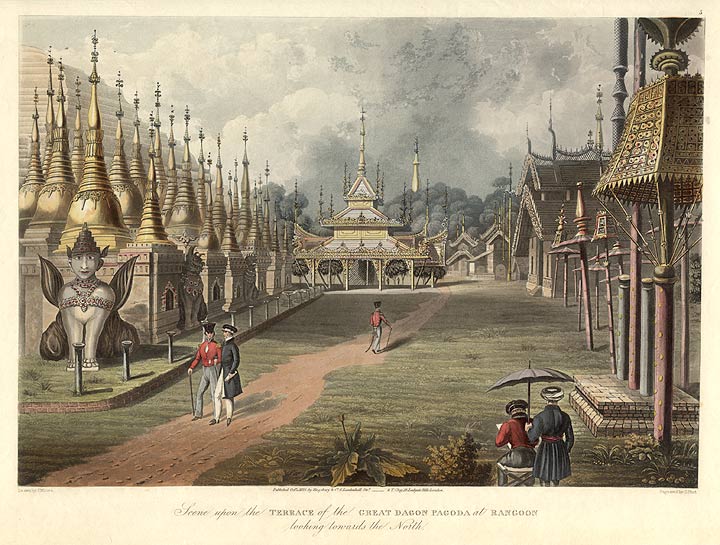|
Ching Thang Khomba
Bhagya Chandra (also known as Ching-Thang Khomba and Jai Singh) (1748–1799) was a king of Manipur in the 18th century CE. He was the grandson of Gharib Niwaz and ruled Manipur for almost forty years (1759–1798). During his rule, he faced several invasions from the Burmese empire and went into exile, but eventually made peace with Burma. Bhagya Chandra is known for spreading Vaishnavism in the Manipur state. He invented the Manipuri Raas Leela dance. His daughter (Shija Laioibi) played the role of Radha at the first performance and became a popular figure in Manipur. Background Bhagya Chandra was the son of Syam Sai, the eldest son and the legitimate heir of King Gharib Niwaz. Gharib Niwaz had however promised the throne to a son of his second wife, Chit Sai (Ajit Shah). Accordingly when Gharib Niwaz abdicated in 1748, Chit Sai became the king. According to the Royal Chronicle, Chit Sai expelled Gharib Niwaz in 1750 and the latter went to Burma, where his niece Sich ... [...More Info...] [...Related Items...] OR: [Wikipedia] [Google] [Baidu] |
List Of Meitei Kings
This is a list of monarchs that ruled the Kingdom of Manipur (present-day Manipur state) as they are recorded in the ''Royal Chronicle of Manipur'' (''Cheitharol Kumbaba''). The Chronicle was reconstructed during the 18th century, with unknown provenance of the earlier sections and, according to scholars, its historicity is assured only for the portions after 1485. The Kingdom of ''Kangleipak'' with written constitution was established in 1110 CE by Loiyumba, ruler of Kangleipak State who incorporated most neighboring principalities.Phanjoubam Tarapot, ''Bleeding Manipur'', Har Anand Publications (30 July 2007) The Kangleipak kings expanded their territory, reaching their zenith under king Khagemba (1597–1652 CE). In 1714, a king named Pamheiba adopted Hinduism. He adopted the name Gharib Nawaz (Manipur), Gharib Nawaz, and in 1724 renamed the kingdom as "Manipur" (Sanskrit for "abode of jewels"). Manipur was Burmese invasions of Assam, conquered by Burma in 1819 CE, and beca ... [...More Info...] [...Related Items...] OR: [Wikipedia] [Google] [Baidu] |
Saint
In Christianity, Christian belief, a saint is a person who is recognized as having an exceptional degree of sanctification in Christianity, holiness, imitation of God, likeness, or closeness to God in Christianity, God. However, the use of the term ''saint'' depends on the context and Christian denomination, denomination. In Anglican Communion, Anglican, Oriental Orthodox, and Lutheranism, Lutheran doctrine, all of their faithful deceased in Heaven are considered to be saints, but a selected few are considered worthy of greater honor or emulation. Official Ecclesiastical polity, ecclesiastical recognition, and veneration, is conferred on some denominational saints through the process of canonization in the Catholic Church or glorification in the Eastern Orthodox Church after their approval. In many Protestant denominations, and following from Pauline usage, ''saint'' refers broadly to any holy Christian, without special recognition or selection. While the English word ''saint'' ... [...More Info...] [...Related Items...] OR: [Wikipedia] [Google] [Baidu] |
Kachari Kingdom
The Dimasa Kingdom also known as Kachari kingdom was a late medieval/early modern kingdom in Assam, Northeast India ruled by Dimasa kings. The Dimasa kingdom and others ( Kamata, Chutiya) that developed in the wake of the Kamarupa kingdom were examples of new states that emerged from indigenous communities in medieval Assam as a result of socio-political transformations in these communities. The British finally annexed the kingdom: the plains in 1832 and the hills in 1834. This kingdom gave its name to undivided Cachar district of colonial Assam. And after independence the undivided Cachar district was split into three districts in Assam: Dima Hasao district (formerly ''North Cachar Hills''), Cachar district, Hailakandi district. The Ahom Buranjis called this kingdom ''Timisa''. In the 18th century, a divine Hindu origin was constructed for the rulers of the Kachari kingdom and it was named Hidimba, and the kings as Hidimbesvar. The name Hiḍimbā continued to be use ... [...More Info...] [...Related Items...] OR: [Wikipedia] [Google] [Baidu] |
Brahmaputra
The Brahmaputra is a trans-boundary river which flows through Southwestern China, Northeastern India, and Bangladesh. It is known as Brahmaputra or Luit in Assamese, Yarlung Tsangpo in Tibetan, the Siang/Dihang River in Arunachali, and Jamuna River in Bengali. By itself, it is the 9th largest river in the world by discharge, and the 15th longest. It originates in the Manasarovar Lake region, near Mount Kailash, on the northern side of the Himalayas in Burang County of Tibet where it is known as the Yarlung Tsangpo River. The Brahmaputra flows along southern Tibet to break through the Himalayas in great gorges (including the Yarlung Tsangpo Grand Canyon) and into Arunachal Pradesh. It enters India near the village of Gelling in Arunachal Pradesh and flows southwest through the Assam Valley as the Brahmaputra and south through Bangladesh as the Jamuna (not to be confused with the Yamuna of India). In the vast Ganges Delta, it merges with the Ganges, popularly kno ... [...More Info...] [...Related Items...] OR: [Wikipedia] [Google] [Baidu] |
Cheitharol Kumbaba
''Cheitharol Kumbaba'' or ''Cheithalon Kumpapa'' (''Ch. K.''), the "Royal Chronicle of Manipur", is a court chronicle of the kings of Manipur, which claims to start from 33 CE and to cover the rule of 76 Kings until 1955. The work of chronicling actually began during the reign of King Kiyamba in 1485 CE. The earlier events were reconstructed later during the reign of Bhagyachandra, presumably from oral sources or from scattered written records. According to scholar Saroj Nalini Parratt, the earlier parts have relatively little detail but contain numerous inaccuracies. But they are still said to be useful in reconstructing Manipur's early history. Etymology Ancient Meitei counting methods involved sticks (''chei'') being placed (''thapa'') to represent a base number. ''Kum'' signifies a period of time and ''paba'' is a verb meaning to read or reckon. The chronicle's title therefore connotes the "placing of sticks or using a base as a means of reckoning the period of time, the y ... [...More Info...] [...Related Items...] OR: [Wikipedia] [Google] [Baidu] |
Asiatic Society Of Bangladesh
The Asiatic Society of Bangladesh is a non political and non profit research organisation registered under both Society Act of 1864 and NGO Affairs Bureau, Government of Bangladesh. The Asiatic Society of Bangladesh was established as the Asiatic Society of East Pakistan in Dhaka in 1952 by a number of Muslim leaders, and renamed in 1972. Ahmed Hasan Dani, a noted Muslim historian and archaeologist of Pakistan played an important role in founding this society. He was assisted by Muhammad Shahidullah, a Bengali linguist. The society is housed in Nimtali, walking distance from the Curzon Hall of Dhaka University, locality of Old Dhaka. History Asiatic Society of Bangladesh traces its origins to The Asiatic Society, which was founded by Sir William Jones in 1784. Some of scholars of the Asiatic Society moved to Dhaka, capital of East Bengal, after the Partition of India. Ahmad Hasan Dani, professor of history at the University of Dhaka, proposed the idea of establishing a ... [...More Info...] [...Related Items...] OR: [Wikipedia] [Google] [Baidu] |
Manipur
Manipur () is a state in northeastern India with Imphal as its capital. It borders the Indian states of Assam to the west, Mizoram to the south, and Nagaland to the north and shares the international border with Myanmar, specifically the Sagaing Region to the east and Chin State to the southeast. Covering an area of 22,330 square kilometers (8,621 mi²), the state consists mostly of hilly terrain with the 1813-square-kilometre (700 mi²) Imphal Valley inhabited by the Meitei (Manipuri) community, historically a kingdom. Surrounding hills are home to Naga and Kuki-Zo communities, who speak Tibeto-Burman languages. The official language and lingua franca, Meitei (Manipuri), also belongs to the Tibeto-Burman family. During the days of the British Raj, Manipur was one of the princely states. Prior to the British departure in 1947, Manipur acceded to the Dominion of India, along with roughly 550 other princely states. In September 1949, the ruler of Manipur signed ... [...More Info...] [...Related Items...] OR: [Wikipedia] [Google] [Baidu] |
Radha
Radha (, ), also called Radhika, is a Hindu goddess and the chief consort of the god Krishna. She is the goddess of love, tenderness, compassion, and devotion. In scriptures, Radha is mentioned as the avatar of Lakshmi and also as the Prakṛti, Mūlaprakriti, the Supreme goddess, who is the feminine counterpart and internal potency (''hladini shakti'') of Krishna. Radha accompanies Krishna in all his incarnations. Radha's birthday is celebrated every year on the occasion of Radhashtami. In relation with Krishna, Radha has dual representation—the lover consort as well as his married consort. Traditions like Nimbarka Sampradaya worship Radha as the eternal consort and wedded wife of Krishna. In contrast, traditions like Gaudiya Vaishnavism revere her as Krishna's lover and the divine consort. In Radha Vallabha Sampradaya and Haridasi Sampradaya, only Radha is worshipped as the Brahman, Supreme being. Elsewhere, she is venerated with Krishna as his principal consort in Nim ... [...More Info...] [...Related Items...] OR: [Wikipedia] [Google] [Baidu] |
Manipuri Raas Leela
Manipuri dance, sometimes also referred to as the Manipuri Raas Leela (), is a jagoi and is one of the major Indian classical dance forms, originating from the state of Manipur. It is one of the Meitei intangible cultural heritage. The "Manipuri dance" is a confluence of four ritualistic traditions – Lai Haraoba, Huyen Langlon, Meitei Nata Sankirtana and Raaslila. Owing to the Meitei civilization, the classical dance form, first formally developed by Meitei Hindu king of the Kingdom of Manipur, is considered to be the highest spiritual expression of the worship of Hindu deity Krishna. Owing to its huge influences on the diverse cultural heritages across the Indian subcontinent, it is recognised by the Sangeet Natak Akademi of the Ministry of Culture of the Government of India as one of the few primary classical dance forms of the Republic of India, and is honoured with the Sangeet Natak Akademi Award for Manipuri annually. It is referred to as the "national dance" ... [...More Info...] [...Related Items...] OR: [Wikipedia] [Google] [Baidu] |
Vaishnavism
Vaishnavism () ), also called Vishnuism, is one of the major Hindu denominations, Hindu traditions, that considers Vishnu as the sole Para Brahman, supreme being leading all other Hindu deities, that is, ''Mahavishnu''. It is one of the major Hindu denominations along with Shaivism, Shaktism, and Smartism. Its followers are called Vaishnavites or ''Vaishnava''s (), and it includes sub-sects like Krishnaism and Ramanandi Sampradaya, Ramaism, which consider Krishna and Rama as the supreme beings respectively. According to a 2020 estimate by The World Religion Database (WRD), hosted at Boston University’s Institute on Culture, Religion and World Affairs (CURA), Vaishnavism is the largest Hindu sect, constituting about 399 million Hindus. The ancient emergence of Vaishnavism is unclear, and broadly hypothesized as a History of Hinduism, fusion of various regional non-Vedic religions with worship of Vishnu. It is considered a merger of several popular non-Vedic theistic traditio ... [...More Info...] [...Related Items...] OR: [Wikipedia] [Google] [Baidu] |
Konbaung Dynasty
The Konbaung dynasty (), also known as the Third Burmese Empire (တတိယမြန်မာနိုင်ငံတော်), was the last dynasty that ruled Burma from 1752 to 1885. It created the second-largest empire in history of Myanmar, Burmese history and continued the administrative reforms begun by the Toungoo dynasty, laying the foundations of the modern state of Burma. The reforms, however, proved insufficient to stem the advance of the British Empire, who defeated the Burmese in all three Anglo-Burmese Wars over a six-decade span (1824–1885) and ended the millennium-old Burmese monarchy in 1885. Pretenders to the dynasty claim descent from Myat Phaya Lat, one of Thibaw's daughters. An expansionist dynasty, the Konbaung kings waged campaigns against the Mizo Chieftainship, Lushai Hills, Möng Mao, Manipur, Assam, Kingdom of Mrauk U, Arakan, the Mon people, Mon kingdom of Restored Hanthawaddy Kingdom, Pegu, Siam, and the Qing dynasty of China—thus establis ... [...More Info...] [...Related Items...] OR: [Wikipedia] [Google] [Baidu] |




